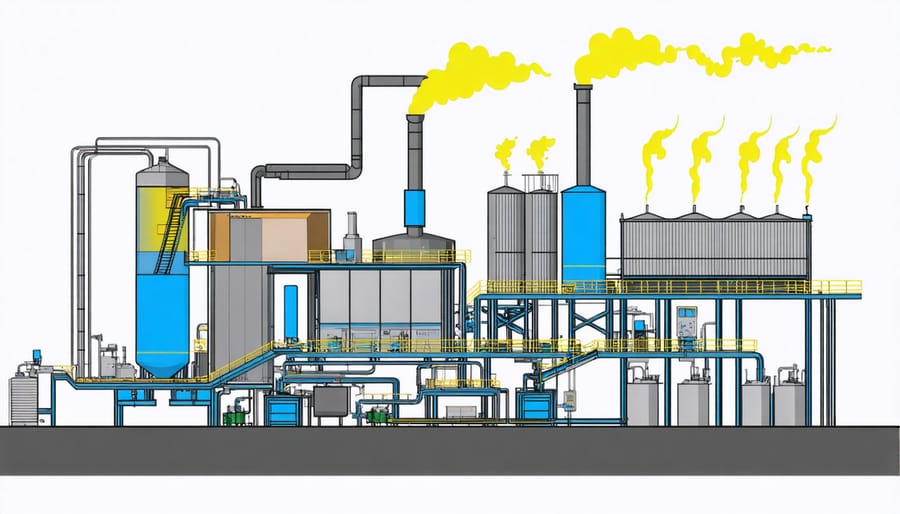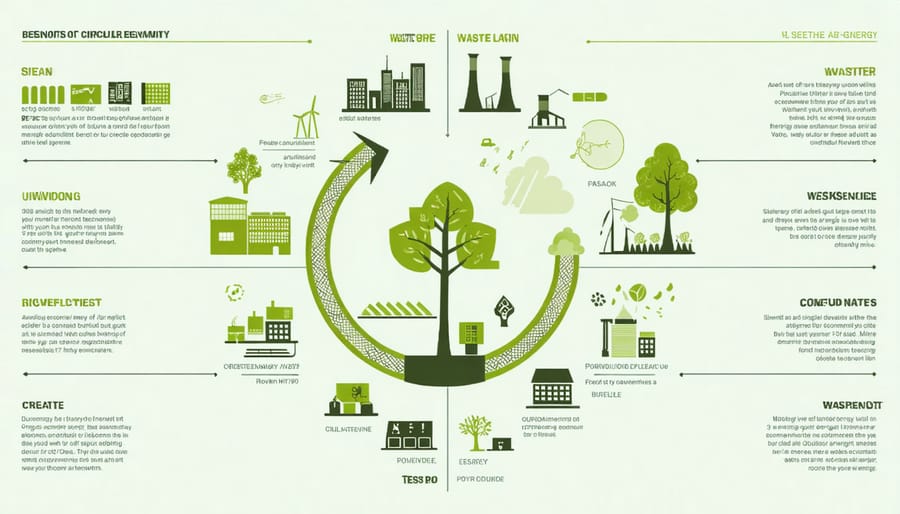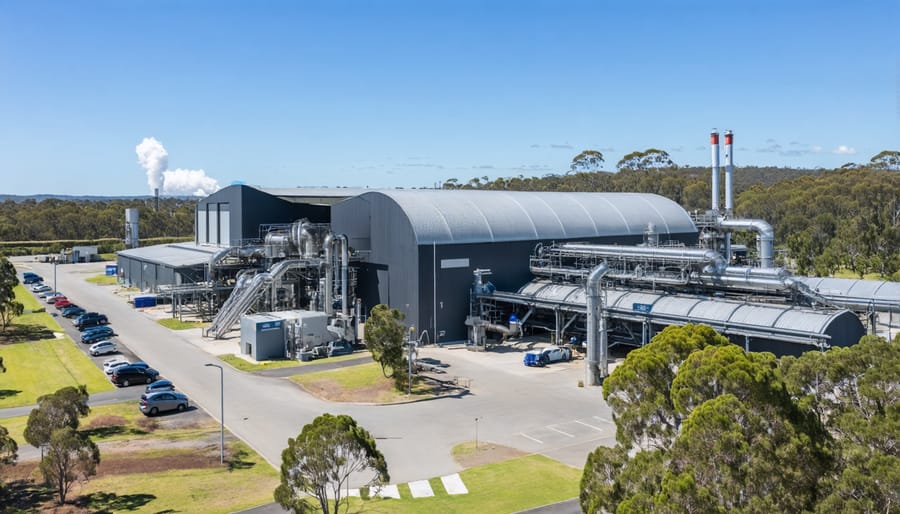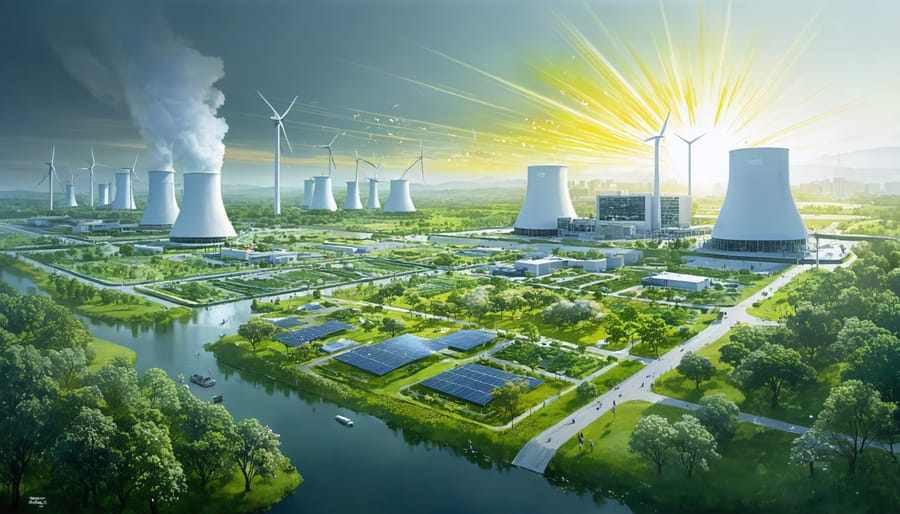In the face of mounting waste challenges and urgent climate action needs, waste-to-energy incineration emerges as a transformative solution bridging waste management and renewable energy production. This advanced technology converts municipal solid waste into clean electricity and heat, offering a dual benefit: reducing landfill dependency while generating sustainable power for communities.
Modern waste-to-energy facilities represent a crucial stepping stone toward circular economy principles, transforming what was once considered worthless into a valuable energy resource. In Australia, where waste management infrastructure faces increasing pressure from population growth and urbanization, these facilities offer a practical pathway to both waste reduction and energy security.
By thermally treating waste at high temperatures under strictly controlled conditions, these facilities not only generate baseload power but also reduce waste volume by up to 90%, while capturing and treating emissions to meet stringent environmental standards. This innovative approach demonstrates how smart technology can transform environmental challenges into opportunities for sustainable development and resource recovery.
From Landfill to Light Switch: Understanding Waste-to-Energy
The Science Behind the Burn
At the heart of waste-to-energy incineration lies a remarkable process that transforms our everyday rubbish into valuable sustainable energy solutions. The process begins in the combustion chamber, where waste is burned at temperatures exceeding 850°C. This intense heat breaks down the waste while releasing energy in the form of hot gases.
These gases pass through a boiler system, where they heat water to create high-pressure steam. The steam then drives a turbine connected to a generator, which converts the mechanical energy into electricity. It’s a bit like a giant kettle powering a sophisticated engine!
The system doesn’t stop there. Modern facilities capture and clean the exhaust gases through multiple treatment stages, removing harmful pollutants before release. Advanced facilities can achieve energy conversion efficiencies of up to 30% for electricity generation, with even higher rates when the excess heat is captured for district heating or industrial processes.
What makes this technology particularly clever is its ability to reduce waste volume by up to 90% while generating power. The remaining ash can be processed to recover metals for recycling, and in some cases, the bottom ash can be used in construction materials, ensuring almost nothing goes to waste. It’s a prime example of turning a challenge into an opportunity, making waste-to-energy facilities an integral part of our journey towards a more sustainable future.

Types of Waste That Power Our Grid
Not all waste is created equal when it comes to energy generation. Municipal solid waste (MSW) serves as the primary fuel for waste-to-energy facilities, with particular focus on materials that offer high calorific value. Paper and cardboard products, non-recyclable plastics, and organic waste are excellent energy sources, producing significant heat when incinerated.
Food waste and green garden materials, which make up roughly 40% of Australian household bins, are particularly valuable. These organic materials not only burn efficiently but also help maintain stable combustion temperatures. Timber waste from construction and demolition sites provides another reliable energy source, offering consistent burn rates and high energy output.
Textiles, certain types of packaging, and commercial waste streams also contribute significantly to the energy mix. However, it’s crucial to note that hazardous materials, electronic waste, and recyclable materials are typically excluded from the incineration process. Instead, these materials are directed to appropriate recycling or disposal facilities.
The key to maximising energy recovery lies in proper waste sorting and processing. Modern facilities can generate around 500-600 kWh of electricity per tonne of waste processed, making waste-to-energy a viable part of our renewable energy future.

Environmental Impact and Circular Economy Benefits
Reducing Landfill Dependence
Waste-to-energy incineration plays a crucial role in reducing our dependence on landfills, offering a sustainable solution to Australia’s growing waste management challenges. By converting waste into energy, these facilities can reduce landfill-bound waste volume by up to 90%, significantly extending the lifespan of existing landfill sites.
For perspective, a typical waste-to-energy facility processing 300,000 tonnes of waste annually can save roughly 3-4 hectares of landfill space each year – that’s about the size of four MCG playing fields. This reduction is particularly vital for urban areas where landfill space is increasingly scarce and valuable.
Beyond space savings, diverting waste from landfills through incineration helps minimize methane emissions, a greenhouse gas 25 times more potent than carbon dioxide. Modern waste-to-energy facilities also recover metals from ash residues, further reducing landfill requirements and supporting resource recovery efforts.
In cities like Sydney and Melbourne, where landfill capacity is reaching critical levels, waste-to-energy facilities are emerging as game-changers in sustainable waste management, offering a practical pathway to a more circular economy while generating renewable energy for local communities.
Emissions and Air Quality Control
Modern waste-to-energy facilities employ sophisticated air quality control measures that effectively minimize environmental impact while maximizing energy recovery. These state-of-the-art systems utilize a multi-stage approach to emissions control, ensuring that harmful pollutants are captured before reaching the atmosphere.
The process begins with advanced combustion control systems that optimize burning conditions to reduce the formation of harmful compounds. Flue gases pass through several treatment stages, including selective catalytic reduction (SCR) for nitrogen oxide removal, activated carbon injection for mercury and dioxin capture, and fabric filters that trap fine particles with remarkable efficiency.
Australian facilities must comply with strict Environmental Protection Authority (EPA) guidelines, often exceeding international standards. Continuous emissions monitoring systems (CEMS) provide real-time data on stack emissions, ensuring transparency and accountability. These monitoring systems track key parameters such as particulate matter, acid gases, and heavy metals, with results regularly reported to regulatory authorities and made available to the public.
Recent technological advances have made it possible to achieve emission levels far below regulatory limits. For instance, modern plants can remove over 99% of particulate matter and significantly reduce greenhouse gas emissions compared to landfilling. The residual ash is carefully managed and can often be repurposed in construction materials, further supporting circular economy principles.
By implementing these comprehensive pollution control systems, waste-to-energy facilities demonstrate that clean energy production from waste is not just possible but increasingly efficient and environmentally responsible. This approach helps communities transition towards sustainable waste management while maintaining excellent air quality standards.
Australian Success Stories and Future Projects

Current Operations Making a Difference
Australia is making significant strides in waste-to-energy innovation, with several facilities leading the way in sustainable waste management. The Kwinana Waste to Energy facility in Western Australia stands as a shining example of success, processing up to 400,000 tonnes of household waste annually while generating enough electricity to power 50,000 homes. This state-of-the-art facility, the first of its kind in Australia, demonstrates how modern incineration technology can effectively address both waste management and energy production needs.
In the Eastern states, the Eastern Creek Energy from Waste Facility in New South Wales is making waves with its innovative approach to managing Sydney’s growing waste challenges. The facility is designed to process up to 500,000 tonnes of residual waste yearly, significantly reducing landfill dependence while contributing clean energy to the local grid.
The Mount Piper Energy Recovery Project near Lithgow showcases how existing power infrastructure can be adapted for waste-to-energy purposes. By co-firing processed waste materials with coal, the facility is helping to reduce both waste volumes and fossil fuel consumption.
These facilities are proving that waste-to-energy incineration isn’t just a theoretical solution – it’s a practical, working reality in Australia. They’re creating local jobs, reducing greenhouse gas emissions from landfills, and generating renewable energy, all while helping communities move closer to their zero-waste goals.
Tomorrow’s Waste Management Solutions
Exciting developments are reshaping waste-to-energy incineration in Australia, paving the way for a clean energy future. The Western Sydney Energy and Resource Recovery Centre, set to commence operations in 2025, will showcase next-generation thermal treatment technology capable of processing 500,000 tonnes of non-recyclable waste annually while powering up to 65,000 homes.
Innovation is driving significant improvements in emissions control and energy efficiency. Advanced artificial intelligence systems are being integrated into new facilities to optimize combustion processes and reduce environmental impact. Smart sensors and real-time monitoring equipment will enable precise control over operations, ensuring maximum energy recovery while minimizing emissions.
Several councils across Australia are exploring modular waste-to-energy solutions that can be scaled according to community needs. These flexible systems will make the technology more accessible to regional areas, creating local energy independence and reducing transportation costs.
The industry is also focusing on ash recycling technologies, turning incineration by-products into valuable construction materials. This circular approach ensures that virtually nothing goes to waste, marking a significant step forward in sustainable waste management.
Community and Economic Benefits
Job Creation and Skills Development
The waste-to-energy sector is emerging as a significant employer in Australia’s renewable energy landscape, creating diverse job opportunities across multiple skill levels. From facility operators and maintenance technicians to environmental scientists and project managers, the industry offers career paths for both technical and non-technical professionals.
A typical waste-to-energy facility employs 30-50 full-time staff members, with additional positions created during construction phases. These facilities require skilled operators to monitor complex systems, engineers to maintain equipment, and environmental specialists to ensure compliance with emissions standards.
The sector also drives indirect employment through waste collection, transportation, and ash management services. Local councils and waste management companies are increasingly partnering with training institutions to develop specialized certification programs, preparing workers for these emerging roles.
Beyond operational jobs, the industry creates opportunities in research and development, focusing on improving efficiency and reducing emissions. This has led to collaborations between industry players and Australian universities, fostering innovation while creating pathways for graduates and researchers.
The growth of waste-to-energy facilities is also boosting employment in regional areas, bringing sustainable jobs to communities traditionally dependent on conventional energy sectors.
Local Energy Security
Waste-to-energy incineration plays a crucial role in strengthening local energy security by providing communities with a reliable, home-grown power source. Unlike traditional energy sources that often rely on imported fuels, waste-to-energy facilities tap into a constant, locally available resource – our everyday waste.
This self-sufficiency is particularly valuable for Australian communities, especially in regional areas where energy infrastructure may be less robust. By converting local waste into electricity and heat, these facilities create a resilient energy network that’s less vulnerable to external supply disruptions or price fluctuations in global energy markets.
The steady nature of waste generation means these facilities can provide baseload power – a consistent energy supply that complements intermittent renewable sources like solar and wind. During extreme weather events or emergencies, waste-to-energy plants can continue operating, providing critical power to essential services and maintaining community resilience.
For local councils and businesses, this energy independence translates into more predictable operating costs and reduced reliance on distant power sources, creating a more sustainable and self-reliant community energy ecosystem.
As Australia moves towards a more sustainable future, waste-to-energy incineration stands out as a promising solution that addresses both our waste management challenges and renewable energy needs. The technology’s ability to reduce landfill waste while generating clean energy positions it as a vital component of our circular economy aspirations.
The success stories we’ve seen across the country, from Perth’s Kwinana facility to emerging projects in other states, demonstrate that waste-to-energy is more than just a concept – it’s a practical, achievable reality for Australian communities. These facilities are proving that we can transform our waste management approach while creating new jobs, reducing greenhouse gas emissions, and providing reliable baseload power.
Looking ahead, the potential for waste-to-energy in Australia is significant. With growing population centres, increasing waste volumes, and ambitious renewable energy targets, this technology offers a smart, efficient solution that aligns with our national sustainability goals. The integration of waste-to-energy facilities into our existing infrastructure can help create a more resilient and sustainable energy network while solving critical waste management issues.
For Australia to fully embrace this opportunity, continued collaboration between government, industry, and communities is essential. By supporting innovation, implementing appropriate regulations, and engaging with local communities, we can ensure that waste-to-energy technology plays a meaningful role in our sustainable future. The path forward is clear: waste-to-energy incineration isn’t just an alternative – it’s an integral part of Australia’s clean energy future.

